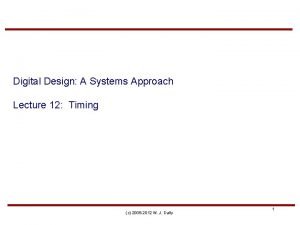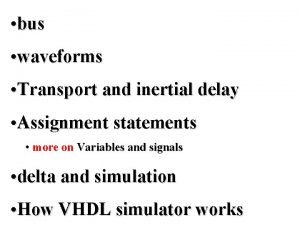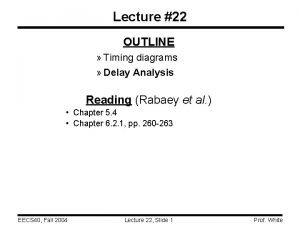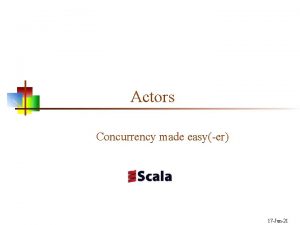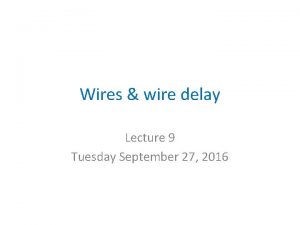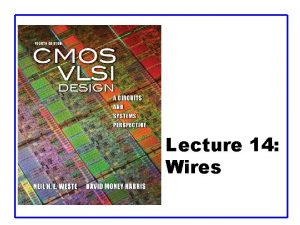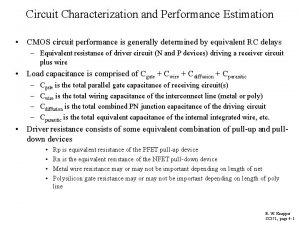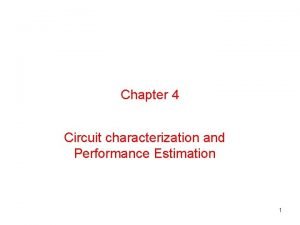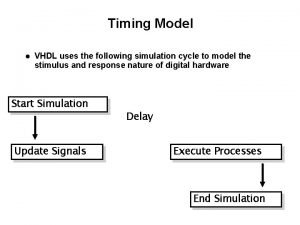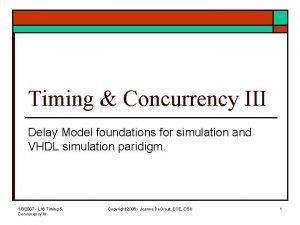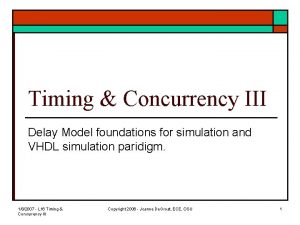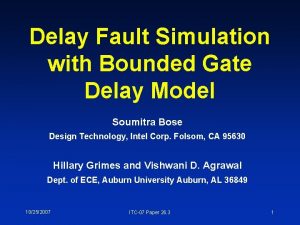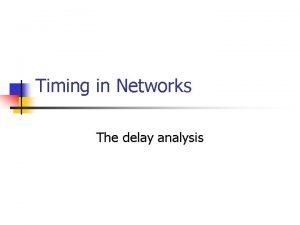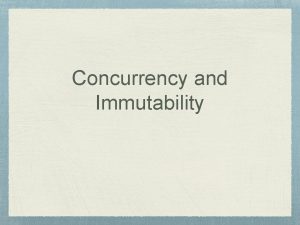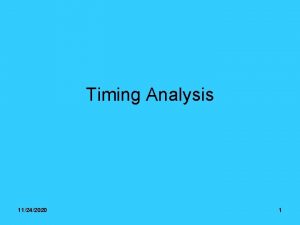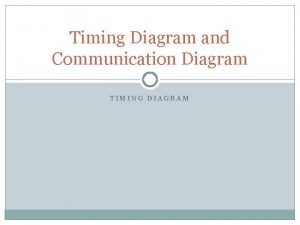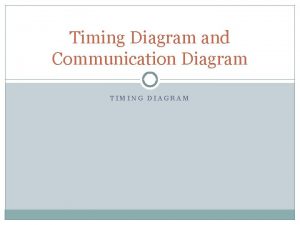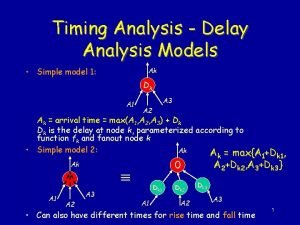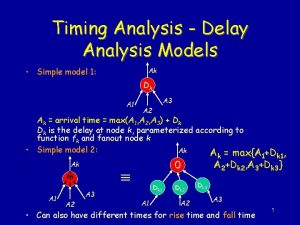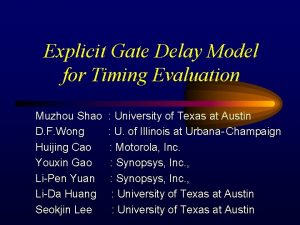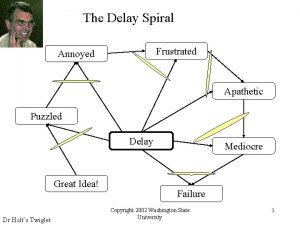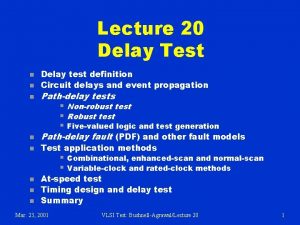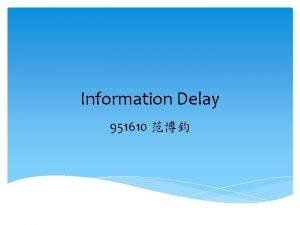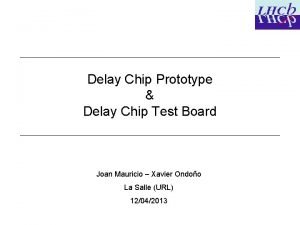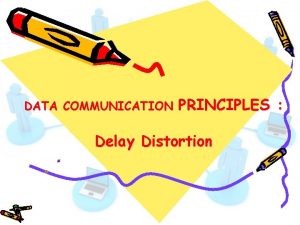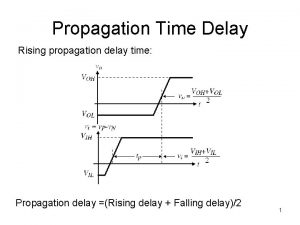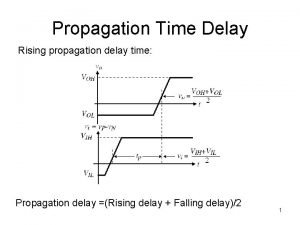Timing Concurrency III Delay Model foundations for simulation































- Slides: 31

Timing & Concurrency III Delay Model foundations for simulation and VHDL simulation paridigm. 1/8/2007 - L 16 Timing & Concurrency III Copyright 2006 - Joanne De. Groat, ECE, OSU 1

Overview – Timing & Concurrency o o o Simulation Techniques The VHDL Simulation Cycle Waveform updating 1/8/2007 - L 16 Timing & Concurrency III Copyright 2006 - Joanne De. Groat, ECE, OSU 2

Delay Models o Rise/Fall Delay Model – allows the specification of different delays for when the output signal rises (0 to 1) and falls (1 to 0) due to electrical properties, and thus enables the designer to more accurately analyze the timing performance of a curcuit. 1/8/2007 - L 16 Timing & Concurrency III Copyright 2006 - Joanne De. Groat, ECE, OSU 3

Delay Models o Ambiguity Delay Model – takes into account the minimum and maximum values for the rise and fall delays. This model deals with a range rather than a specific value for the delays. The range, know as the ambiguity region, specifies the limits within which the signal changes. This region will tend to accumulate or “stretch” as it propagates through the circuit. Good for worst case analysis. 1/8/2007 - L 16 Timing & Concurrency III Copyright 2006 - Joanne De. Groat, ECE, OSU 4

Delays Models o Inertial Delay Model – In order to switch state, logic gates require that the input pulse cross a certain threshold and remain unchanged for a certain period of time (hold time). If the pulse is small, the gate will not change state. The minimum pulse width for an input pulse to cause a change in state for a gate or other device is called the inertial delay of the gate or device. 1/8/2007 - L 16 Timing & Concurrency III Copyright 2006 - Joanne De. Groat, ECE, OSU 5

Inertial delay o Consider the following gate. n The inertial delay of the gate is 2 time units. o 1/8/2007 - L 16 Timing & Concurrency III WHAT IF THE PULSE IS 1 TIME UNIT? Copyright 2006 - Joanne De. Groat, ECE, OSU 6

Inertial delay o Consider the following gate. n The inertial delay of the gate is 2 time units. o o o WHAT IF THE PULSE IS 1 TIME UNIT? Output does not change High Frequency signal rejection a property that digital gates have Input signal on A Response on Output C - NADA 1/8/2007 - L 16 Timing & Concurrency III Copyright 2006 - Joanne De. Groat, ECE, OSU 7

Inertial delay o Consider the following gate. n The inertial delay of the gate is 2 time units. o 1/8/2007 - L 16 Timing & Concurrency III WHAT IF THE PULSE IS 2 TIME UNITs? Copyright 2006 - Joanne De. Groat, ECE, OSU 8

Inertial delay o Consider the following gate. n The inertial delay of the gate is 2 time units. o o 1/8/2007 - L 16 Timing & Concurrency III WHAT IF THE PULSE IS 2 TIME UNITs? Gate responds with a 2 TIME UNIT delay from the input. Copyright 2006 - Joanne De. Groat, ECE, OSU 9

Inertial delay o Consider the following gate. n The inertial delay of the gate is 2 time units. o o 1/8/2007 - L 16 Timing & Concurrency III WHAT IF THE PULSE IS 3 TIME UNITs? Gate responds with a delay of 2 TIME UNITs. Copyright 2006 - Joanne De. Groat, ECE, OSU 10

Inertial delay o Consider the following gate. n The inertial delay of the gate is 2 time units. o o 1/8/2007 - L 16 Timing & Concurrency III WHAT IF THE PULSE IS 2 or greater (3) TIME UNITs? Gate responds with a 2 TIME UNIT delay from the input. Copyright 2006 - Joanne De. Groat, ECE, OSU 11

A final word on Inertial Delay o o Inertial Delay allows for high-frequency signal rejection – filtering out short spikes or pulses at the input that have a width shorter than the inertial delay of the gate. And we can see this in circuit simulation of real gates. 1/8/2007 - L 16 Timing & Concurrency III Copyright 2006 - Joanne De. Groat, ECE, OSU 12

Spice simulation o o o o Spice circuit simulator NAND GATE 200 p. F load B input held at 1 Input pulse width of 10 ns. Input has a 1 ns rise and fall time Note output shape 1/8/2007 - L 16 Timing & Concurrency III Copyright 2006 - Joanne De. Groat, ECE, OSU 13

Spice Simulation 2 o o Input pulse shortened to 5 ns Note that output never quite falls fully to 0. 1/8/2007 - L 16 Timing & Concurrency III Copyright 2006 - Joanne De. Groat, ECE, OSU 14

Spice Simulation 3 o o Now shorten the input to a 2 ns pulse with a 1 ns rise time and a 1 ns fall time Note that output would barely (if even) reach the treshold need to trigger the next gate. 1/8/2007 - L 16 Timing & Concurrency III Copyright 2006 - Joanne De. Groat, ECE, OSU 15

Spice Simulation 4 o o Now shorten the pulse to 1 ns Change on output is not sufficient to even come close to causing a change on the subsequent gate as you only drop to ~3. 5 V on the output of this gate. 1/8/2007 - L 16 Timing & Concurrency III Copyright 2006 - Joanne De. Groat, ECE, OSU 16

Delay Models o Transport Delay Model – The transport delay for an element can be modeled as shown and is a delay simply added to the output of the element. If all delays were set to 1 this is a unit delay simulator. If the delay for all elements are set to 0, it is a zero delay simulator. It will not show an accurate measure of the circuits timing performance. Glitches will get through that would not appear in a real circuit. 1/8/2007 - L 16 Timing & Concurrency III Copyright 2006 - Joanne De. Groat, ECE, OSU 17

Inertial and transport delay in VHDL o VHDL 1987 n n n Inertial Delay Example: X <= A and B AFTER 5 NS; Here 5 NS is both the gate delay and the inertial delay of the gate. Transport Delay Example: X<=transport A and B AFTER 5 NS; Here 5 NS if the transport gate delay and there is no high-frequency pulse rejection. 1/8/2007 - L 16 Timing & Concurrency III Copyright 2006 - Joanne De. Groat, ECE, OSU 18

Inertial and transport delay in VHDL o VHDL 1993 and on (including VHDL 2009) n n n n signal_assignment_statement: [label: ]target<=[delay_mechanism] waveform; delay_mechanism: : = transport | [reject time_expression] inertial target: : = name | aggregate waveform: : = waveform_element {, waveform_element} 1/8/2007 - L 16 Timing & Concurrency III Copyright 2006 - Joanne De. Groat, ECE, OSU 19

Inertial and transport delay in VHDL o VHDL 1993 and on example n n n n n The following 3 are equivalent to each other X <= A and B after 4 ns; --inertial(same as 87) X <= inertial A and B after 4 ns; X <= reject 4 ns inertial A and B after 4 ns; Assignments with pulse rejection limit < device delay X <= reject 5 ns inertial A and B after 10 ns; X <= reject 3 ns inertial A and B after 10 ns, A nand B after 20 ns; Note: Reject time must be < or = smallet delay in after clause. Transport Delay is the same at in the ’ 87 standard. 1/8/2007 - L 16 Timing & Concurrency III Copyright 2006 - Joanne De. Groat, ECE, OSU 20

The VHDL Simulation Cycle o Initialization Phase n n 1. The effective value of each declared signal is computed, and the current value of the signal is set to this effective value. The value is assumed to have been the value of the signal for an infinite length of time prior to the start of simulation. 2. The value of each implicit signal of the form S’Stable(T) or S’Quiet(T) is set to TRUE. 3. The value of each implicit GUARD is set to the result of evaluating the corresponding guard expression. Each process in the model is executed until it suspends. At the beginning of simulation the current time is assumed to be 0 ns. 1/8/2007 - L 16 Timing & Concurrency III Copyright 2006 - Joanne De. Groat, ECE, OSU 21

The VHDL Simulation Cycle o Simulation Phase (repeats till quiescent) n n n o A simulation cycle consists of the following steps: 1. If no driver is active, then simulation time advances to the next time at which a driver becomes active or a process resumes. Simulation is complete when time advances to TIME’HIGH. 2. Each active explicit signal in the model is updated. (Events may occur as a result. ) 3. Each implicit signal in the model is updated. (Events may occur on signals as a result. ) 4. For each process P, if P is currently sensitive to a signal S, and an event has occurred on S in this simulation cycle, then P resumes. 5. Each process that has just resumed is executed until it suspends. Advance Time Update Signal Values Mark Sensitive Processes Run Resumed Processes 1/8/2007 - L 16 Timing & Concurrency III Copyright 2006 - Joanne De. Groat, ECE, OSU 22

Updating the Projected Output Waveform o o o When a signal assignment statement is executed a transaction is generated Transactions consist of a value time pair Updating a projected output waveform consists of the deletion of zero or more previously computed transactions (called old transactions) from the projected output waveform, and the addition of new transactions, as follows: 1/8/2007 - L 16 Timing & Concurrency III Copyright 2006 - Joanne De. Groat, ECE, OSU 23

Updating the Projected Output Waveform I n n o 1. All old transactions that are projected to occur at or after the time at which the earliest new transaction is projected to occur are deleted from the projected output waveform. 2. The new transactions are then appended to the projected output waveform in the order of their projected occurrence. If the reserved word transport does not appear in the corresponding signal assignment statement then the delay is considered to be inertial delay, and the projected waveform is further modified as follows: 1/8/2007 - L 16 Timing & Concurrency III Copyright 2006 - Joanne De. Groat, ECE, OSU 24

Updating the Projected Output Waveform II o For inertial delay: n n n 1. All of the new transactions are marked. 2. An old transaction is marked if it immediately precedes a marked transactions and its value component is the same as that of the marked transaction. 3. The transaction that determines the current value of the driver is marked. 4. All unmarked transactions (all of which are old transactions) are deleted from the projected output waveform. 93 addition of the reject limit slightly modifies this in that the reject time is used here. 1/8/2007 - L 16 Timing & Concurrency III Copyright 2006 - Joanne De. Groat, ECE, OSU 25

Example – 1 st part (87 on) o Current state o 1. Delete at or after 1/8/2007 - L 16 Timing & Concurrency III Copyright 2006 - Joanne De. Groat, ECE, OSU 26

Example (cont) o After appending o And Marking 1/8/2007 - L 16 Timing & Concurrency III Copyright 2006 - Joanne De. Groat, ECE, OSU 27

Example o And now delete the unmarked 1/8/2007 - L 16 Timing & Concurrency III Copyright 2006 - Joanne De. Groat, ECE, OSU 28

Updating the Projected Output Waveform II – 93 mod o For inertial delay: n n 1. All of the new transactions are marked. 2. An old transaction is marked if it immediately precedes a marked transactions and its value component is the same as that of the marked transaction or it precedes a marked transaction by more than the reject time such that the reject time for the preceding transaction has elapsed. 3. The transaction that determines the current value of the driver is marked. 4. All unmarked transactions (all of which are old transactions) are deleted from the projected output waveform. 1/8/2007 - L 16 Timing & Concurrency III Copyright 2006 - Joanne De. Groat, ECE, OSU 29

Example of no reject time o Have the concurrent statement n o o x <= A after 5 ns; At 10 ns A has an event. The transaction just gets appended to the CV At 13 ns a new transaction is generated, is appended, and then the algorithm run The inertial algorithm causes deletion of the transaction at 15. Transaction here gives (value, post time) 1/8/2007 - L 16 Timing & Concurrency III Copyright 2006 - Joanne De. Groat, ECE, OSU 30

Example (93 and on with reject) n n o o x <= reject 3 ns inertial A after 5 ns; Transactions has reject term to show reject time At 10 it is just appended like before At 13 ns the transaction is appended and then marked as it is a new transaction. The existing transaction is also Marked as the reject time has elapsed. Transaction here is in form (value, reject time, post time) 1/8/2007 - L 16 Timing & Concurrency III Copyright 2006 - Joanne De. Groat, ECE, OSU 31
 Propagation delay
Propagation delay Difference between signal and variable in vhdl
Difference between signal and variable in vhdl Plc timers
Plc timers Propagation delay timing diagram
Propagation delay timing diagram Hamlet act iii scene iii
Hamlet act iii scene iii Actor model concurrency
Actor model concurrency Wire delay
Wire delay Distributed rc delay model
Distributed rc delay model Distributed rc delay model
Distributed rc delay model Distributed rc delay model
Distributed rc delay model Timing model
Timing model Kontinuitetshantering i praktiken
Kontinuitetshantering i praktiken Typiska novell drag
Typiska novell drag Nationell inriktning för artificiell intelligens
Nationell inriktning för artificiell intelligens Ekologiskt fotavtryck
Ekologiskt fotavtryck Varför kallas perioden 1918-1939 för mellankrigstiden?
Varför kallas perioden 1918-1939 för mellankrigstiden? En lathund för arbete med kontinuitetshantering
En lathund för arbete med kontinuitetshantering Särskild löneskatt för pensionskostnader
Särskild löneskatt för pensionskostnader Tidbok yrkesförare
Tidbok yrkesförare Sura för anatom
Sura för anatom Vad är densitet
Vad är densitet Datorkunskap för nybörjare
Datorkunskap för nybörjare Stig kerman
Stig kerman Hur skriver man en tes
Hur skriver man en tes Magnetsjukhus
Magnetsjukhus Nyckelkompetenser för livslångt lärande
Nyckelkompetenser för livslångt lärande Påbyggnader för flakfordon
Påbyggnader för flakfordon Formel för lufttryck
Formel för lufttryck Svenskt ramverk för digital samverkan
Svenskt ramverk för digital samverkan I gullregnens månad
I gullregnens månad Presentera för publik crossboss
Presentera för publik crossboss Argument för teckenspråk som minoritetsspråk
Argument för teckenspråk som minoritetsspråk
